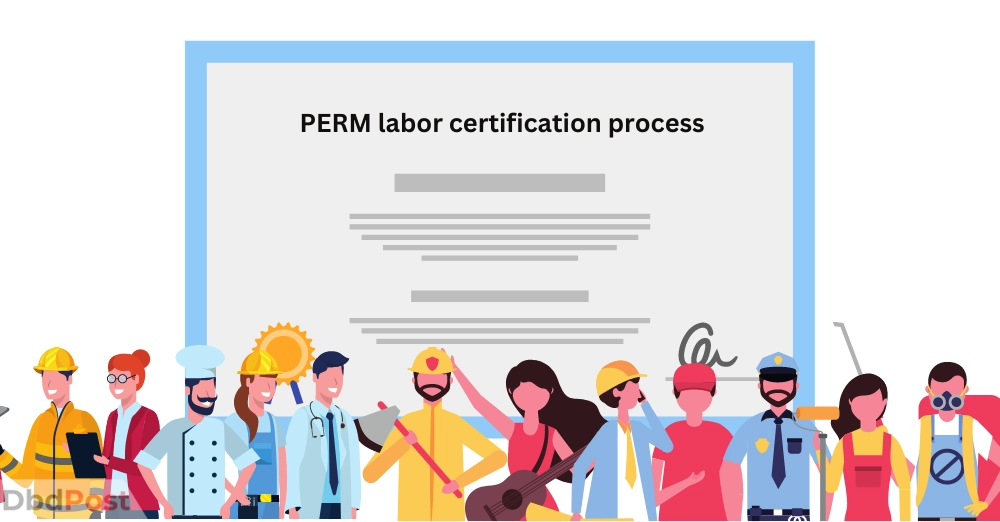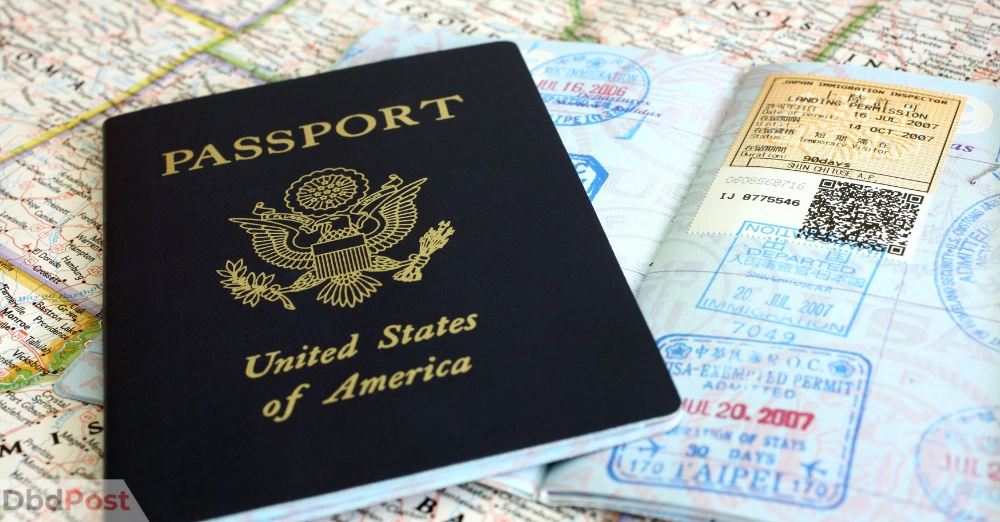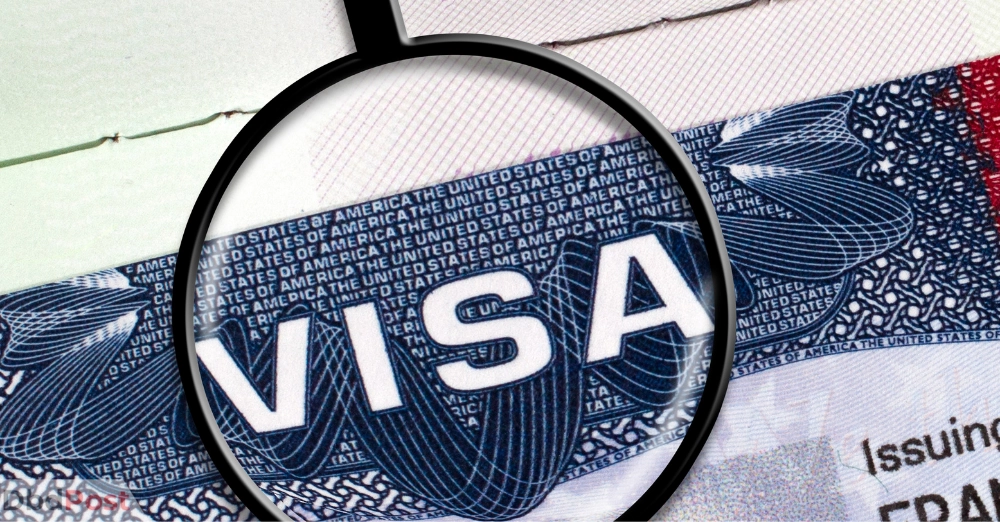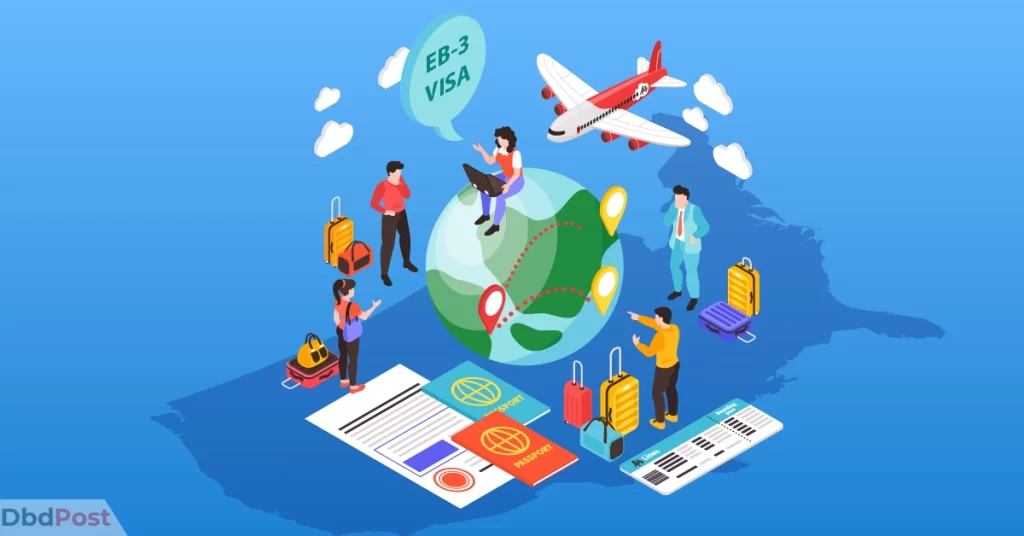The EB-3 visa is an employment-based visa that allows foreign workers to live and work in the United States. It’s also an excellent option for individuals who want to work and live in the US.
Obtaining an EB-3 visa can be a confusing and lengthy process. The process involves various steps: application, fees, processing time, and meeting specific requirements.
This Dbd guide aims to assist in quickly obtaining an EB-3 visa for foreign workers. This employment-based category three visa is designed for skilled workers, professionals, and workers with at least two years of work experience.
What is EB-3 visa?

EB-3 visa is an employment-based immigration visa that allows foreign workers to work and live in the United States. EB-3 visas are different than non-immigrant visas and temporary work visas.
The purpose of the third preference visa is to provide a pathway for foreign workers who are skilled, unskilled, or professional workers.
Employment-based immigration visas are divided into five categories. Let’s look into each category in detail.
EB-1 visa
The EB-1 visa is designed for individuals who possess extraordinary abilities. Outstanding professors, researchers, multinational executives, or managers can apply for this visa.
The eligibility criteria for each category are as follows: [1]US government, “EB-1 visa, … Continue reading
- Extraordinary ability: Applicant must show extraordinary abilities. You must provide evidence of achievements and recognition in their field.
- Outstanding professors or researchers: Applicants must have at least three years of experience in teaching or research. You must have a job offer from a US employer to apply for this visa.
- Multinational executives or managers: Applicants must have been employed for at least one of the three preceding years by the overseas affiliate, parent, subsidiary, or branch of the US employer. Also, you must have a job offer from a US employer.
EB-2 visa
The EB-2 visa is for professionals with advanced degrees or exceptional abilities in sciences, arts, or business. The eligibility criteria are as follows:
- Advanced degree: Applicants must have a master’s or higher or a bachelor’s degree with at least five years of progressive experience.
- Exceptional ability: Applicants must demonstrate exceptional ability in sciences, arts, or business.
EB-3 visa
The EB-3 visas are for skilled, unskilled, and professional workers. It is divided into three subcategories: [2]US Government, “EB-3 Visa, … Continue reading
- Skilled workers: Applicants must have at least two years of experience or training in a skilled profession or trade with at least two years of experience or training.
- Unskilled workers: Applicants must be capable of performing unskilled labor for which there are no available US workers.
- Professionals: Applicants must have at least a bachelor’s degree or equivalent in a professional field such as medicine, law, engineering, accounting, or teaching.
Applicants must have a permanent job offer from a US employer willing to sponsor them.
EB-4 visa
The EB-4 visa is for special immigrants such as religious workers, broadcasters, and translators. Some subgroups in this visa category are as follows:
- Ministers of Religion
- Certain employees or former employees of the U.S. Government abroad
- Certain former employees of the U.S. Government in Panama
- Iraqi and Afghan translators/interpreters
- Certain foreign medical graduates
- Special immigrant juveniles
- Persons recruited outside of the US enlisted to Serve in the U.S. Army
- Certain retired NATO-6 civilians
- Certain Unmarried Sons and Daughters of NATO-6 civilians
- Certain Surviving Spouses of deceased NATO-6 civilian employees
- Certain Religious Workers
EB-5 visa
The EB-5 visa is for investors who invest a certain amount of capital in the US and create jobs for US workers.
Applicants must invest at least $1 million or $500,000 (U.S.) in a high-unemployment or rural area.
Specifically, the EB-3 visa is divided into three subcategories. Now, let’s look into detail the three categories of EB-3 visas.
1. Skilled Workers (EB-3 visa)

This category is for foreign workers with at least two years of experience or training in a skilled profession or trade. The eligible professions or trades should require at least two years of experience or training.
The applicant must have a permanent job offer from a US employer willing to sponsor them. [3]USCIS, “EB3 skilled visa, … Continue reading
Eligibility criteria
- At least two years of experience or training in a skilled profession or trade.
- A permanent job offer from a US employer.
Documents required
- Proof of work experience or training.
- Educational qualifications and certificates.
- Job offer letter from a US employer.
- Passport and other identification documents.
Application fees & processing time
- The application fee is $700.
- The processing time can vary depending on the country of residence and the workload of the USCIS. Typically, it takes 12 to 36 months.
2. Professionals (EB-3 visa)

This category is for foreign workers with at least a bachelor’s degree or equivalent in medicine, law, engineering, accounting, or teaching.
The applicant must have a permanent job offer from a US employer willing to sponsor them.
Eligibility criteria
- At least a bachelor’s degree or its equivalent in a professional field.
- A permanent job offer from a US employer.
Documents required
- Educational qualifications and certificates.
- Proof of work experience or training.
- Job offer letter from a US employer.
- Passport and other identification documents.
Application fees & processing time
- The application fee is $700.
- The processing time can vary depending on the country of residence and the workload of the USCIS. Typically, it takes as long as skilled worker EB-3 visas.
3. Unskilled Workers (Other Workers) (EB-3 visa)

This category is for foreign workers capable of performing unskilled labor for which no US workers are available. The eligible professions or trades should not require more than two years of experience or training.
The applicant must have a permanent job offer from a US employer willing to sponsor them.
Eligibility criteria
- Capable of performing unskilled labor.
- A permanent job offer from a US employer.
Documents required
- Proof of work experience or training.
- Relevant post-secondary education certificates.
- Job offer letter from a US employer.
- Passport and other identification documents.
Application fees & processing time
- The application fee is $700.
- The processing time can vary depending on the country of residence and the workload of the USCIS. Typically, it takes 12 to 36 months.
How to apply for an EB-3 visa? (step-by-step process)
Employment-based category 3 visa is one of the sought immigration options for applying for a green card in the United States.
We will look into a step-by-step guide on applying for EB-3 visas.
Step 1: PERM labor certification process

To obtain an EB-3 visa, a labor certification must be filed through the Department of Labor (DOL). This certification aims to prove to the DOL that no qualified workers are available for the position in the US. [4]DOL, “Labor certification overview, … Continue reading
Moreover, the employer must determine their potential employee’s appropriate visa preference category to file a labor certification. Afterward, the employer must complete and submit the ETA 9089 form to the DOL.
The documents and details the employer needs to provide in this form are as follows:
- Detailed business information (Name, location, contact, number of employees, and more)
- Employer or sponsor information
- Attorney info (if applicable)
- Wage information in detail
- Job details and criteria
- Immigrant personal details and more
The ETA 9089 form can be complex and requires careful attention to detail to ensure a successful application.
Step 2: Filing form I-140

To apply for an EB-3 visa, an employer must file Form I-140, the Immigrant Petition for Alien Worker. This form aims to establish that the foreign worker is eligible.
The eligibility is based on qualifications (if applicable), job offers, and the employer’s needs.
- First, download the I-140 form from the official USCIS website. Next, complete the form providing information about the sponsor and employer’s details.
- Additionally, provide details on the immigrant, like name, date of birth, country of birth, and citizenship.
- Provide education qualifications (if applicable), work experience, and any relevant certifications or licenses.
- The employer must also provide details about the job, including the job title, duties, and salary.
- Once the form is completed, submit it, along with the required employment authorization document and filing fee, to the USCIS.
- Supporting documents may include proof of the employer’s ability to pay the offered salary.
The process can be complex, so following the instructions carefully and seeking legal assistance is essential.
Step 3: Filing Form I-485 or DS-260

Adjustment of status and consular processing are two different methods for obtaining an EB-3 visa.
Adjustment of status
Adjustment of status is applying for PR while you are in the United States. This process is available for a valid nonimmigrant visa and is eligible for EB-3.
Consular processing
Consular processing is applying for an immigrant visa outside the United States. This process is available to individuals who are not currently in the United States or are not eligible for adjustment of status.[5]USCIS, “Consular processing, https://www.uscis.gov/green-card/green-card-processes-and-procedures/consular-processing”
The requirements for filing Form I-485 or DS-260 can vary depending on the applicant. However, some standard requirements include the following:
Medical examination
All applicants for permanent residency must undergo a medical examination. This ensures they do not have any medical conditions that would render them inadmissible to the United States.
Background checks
All applicants for permanent residency must undergo a background check. This step helps to identify any criminal records or immigration violations.
Biometrics
For security and identity purposes, you must provide biometric information, including fingerprints and photographs.
Documentation
EB-3 applicants must provide supporting or additional documentation. The documents include birth certificates, marriage certificates, and police certificates..
Step 4: Interview and approval

The interview process for an EB-3 visa typically involves a meeting with a consular officer at a U.S. embassy. The purpose of the interview is to verify the information and to determine the applicant’s eligibility.
During the interview, the consular officer may ask questions regarding education, work experience, and the job offer. They may also ask about the applicant’s ties to their home country and their intent to go to the US.
Possible interview outcomes include approval, denial, or additional information requests. If the application is approved, the applicant will receive their passport with the visa stamp affixed to it.
Step 5: Visa issuance and entry to the US

After the visa is approved, you must obtain a visa stamp at a U.S. consulate or embassy in your home country. Additionally, you must provide a passport, a copy of their visa approval notice, and supporting documents.
Upon arrival in the U.S., the applicant must present their passport and visa at the port of entry. Here you need to provide fingerprints and have a brief interview with a Customs and Border Protection officer. [6]US government, “What to expect after approval, https://ar.usembassy.gov/visas/what-to-expect-after-your-visa-is-approved-and-issued/”
How long does it take to get an EB-3 visa?

The processing time for an EB-3 visa can vary depending on various factors. The factors include the applicant’s country of origin, backlog, and more.
Generally, the processing time for an EB-3 visa can range from 1 to 3 years. However, these processing times are subject to change and can vary based on individual circumstances.
Visa bulletin
The processing time for EB-3 visas can also be impacted by the visa bulletin published by the Department of State each month.
The visa bulletin lists the availability of immigrant visas based on the applicant’s priority date (the date the petition was filed).
If there is a backlog in the EB-3 category, the processing time for a visa may be significantly longer.
Consular processing
Another delaying factor is the immigration law on consular processing time. This involves obtaining a visa through a U.S. embassy or consulate in the applicant’s home country.
The steps for consular processing include determining eligibility, filing an immigrant petition, waiting for a decision on the petition, and more.
In summary, the processing time for an EB-3 visa can vary depending on several factors. It is essential to consult with an immigration attorney or the USCIS website for up-to-date information.
How much does it cost to apply for an EB-3 visa?

The cost of applying for an EB-3 visa varies depending on several factors. Employers sponsoring foreign workers for an EB-3 visa must pay a $700 filing fee for Form I-140, the Immigrant Petition for Alien Workers.
If premium processing is requested, the fee increases. Additionally, there is a $345 fee for the visa itself. [7]US government, “Fees, https://travel.state.gov/content/travel/en/us-visas/employment.html”
As an EB-3 visa applicant, you will be responsible for paying for several costs, including medical fees and document translation (if necessary). Also, additional fees include counselor fees, English language proficiency tests, and visa issuance fees.
The total cost of these fees can vary depending on the country of origin and other factors. Budgeting accordingly and being aware of all fees associated with the EB-3 visa application process is essential.
How to check EB-3 visa consular processing current update?

To check the current processing times, you can visit dedicated web pages run by the USCIS. Below we have listed some authorized sources.
- Visa bulletin: It provides information on visa availability and priority dates for each immigrant category. It updates monthly and shows the current processing times based on the applicant’s country of origin and priority date.
Website: Visa bulletin
- USCIS processing time checker: In addition, applicants can check the USCIS website for updates on the processing times for visa petitions. The USCIS website provides processing times for various applications, including visa form I-140 and the petition for EB-3 visas.
Website: Processing times
- US Embassy: Another valuable resource for checking the EB-3 visa consular processing update is your country’s U.S. embassy. Each embassy or consulate provides specific information on its website about visa services, processing times, etc.
Website: US Embassy
Related Info
- Find out everything you need to know about EB-3 Visa for nurses with our guide.
- Find the best EB-3 Visa lawyer with our guide – here.
FAQs
Can an F1 student apply for an EB3 visa?
Yes, an F1 student can apply for an EB-3 visa if they meet the eligibility requirements. You can apply via adjustments of status, such as having a job offer from a U.S. employer and the necessary qualifications for the job.
How many EB-3 visas are there a year?
The number of EB-3 visas available each year is limited by a quota system. The annual quota for EB-3 visas is approximately 40,000, but this number may vary.
Can asylum seeker apply for EB-3 visa?
Yes, an asylum seeker can apply for an EB-3 visa for a Green Card in the US. Those who meet the eligibility requirements can apply without any issues.[8]USCIS, “Green card for asylees, https://www.uscis.gov/green-card/green-card-eligibility/green-card-for-asylees#:~:text=U.S.%20immigration,before%20you%20apply.”
What is the difference between an EB-2 visa and an EB-3 visa?
The main difference between the EB-2 and EB-3 visas is the required qualifications for the job. The EB-2 visa requires more advanced degrees or exceptional ability than the EB-3 requirements.
Final thoughts
In conclusion, obtaining an EB-3 visa can be a complex process that involves careful planning and attention. You should know the eligibility requirements, processing times, and visa availability.
It is recommended to seek the assistance of an experienced immigration attorney while applying for EB-3 green card.
Staying informed and following the proper procedures can increase your chances of obtaining an EB-3 immigrant visa.
- 107shares
- Facebook Messenger
About the author
DbdPost Staff is a team of writers and editors working hard to ensure that all information on our site is as accurate, comprehensive, and trustworthy as possible.
Our goal is always to create the most comprehensive resource directly from experts for our readers on any topic.




